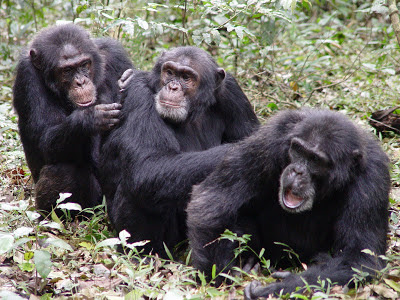
These male chimpanzees practise social grooming (courtesy of Mad Science @ QHST)
Noticed why your birthday photos are more well “liked” than a business update?
Or that people whom you “liked” and “commented” on tend to return the favour?
Why are some friends a lot more popular than others on social networks?
For ease of remembrance, let us label these the 3 Gs of social intercourse.
Gabbing
The first thing you need to do is to let your guard down and share. Let others know your thoughts, your encounters, and your experiences in life. Instagram a photo (or 10), share an insight, or upload a video. Spread the joy and seek the views of others.
While I am an advocate of transparency and openness, there are occasions where you need to hold your tongue (or your fingers, rather). Try to avoid over sharing and clogging up your friends’ Facebook or Twitter feeds with too much minutiae chronicling every hour of your life.
This varies of course, depending on your own “celebrity” status. However, I would advocate some form of content curation rather than spilling every damn thing in your gut all of the time.
So what happens after you’ve shared and posted?
Grooming
The second phenomena to consider is social grooming (or allogrooming).
With its background in primatology (the study of apes), social grooming in the real world comprises the little touches we do to help each other look better. They include picking up a stray strand of hair, straightening a person’s crumpled shirt, or dusting off powder from his shoulder.
On the social web, these little strokes are translated into actions such as Facebook’s infamous “pokes”, shares, likes, and comments, as well as retweets and @ replies on Twitter. These micro interactions help to keep relationships alive in an age of hyper-connectivity and “always on” digital consciousness.
You’ve probably noticed that principle of reciprocity works here. People whom you’ve interacted with more tend to return the favour (unless they are digeratis or celebrities). This brings us to our final point.
Gifting
Some have labelled the social web as the onset of the “gift economy“. Through the click of a button, tapping of a few lines, and sharing of a post or two, one can engender goodwill and cultivate positive friendships.
On the social web, gifting means a lot more than just retweeting and liking. It can also result in new content such as blog posts being created (making positive reference to the original source), or even result in real life transactions such as a meet-up, purchase or event attendance.
Gifting also means being generous in what you share online or offline. It means being ready to provide useful leads or information that can help others at work or in life. It means being connecting people to like-minded others who are able to add value.
In general, the more invested you are in helping others, the more others would pay it back. The universal principle of kindness begetting kindness definitely applies here. This applies equally to the online and offline world.
Of course, one shouldn’t just “give” with the expectation of receiving something in return. That reeks of being calculative and mercenary. Its probably more of paying it forward than anything else.
Naturally, there are some who do not follow the above precepts as much as others. There are also others who are so exact in measuring out their quotas of gabbing, grooming and gifting that they frighten me.
Whatever the case may be, you have the power to decide how “social” you want to be. Hopefully, the 3 Gs give you an idea of what you should and should not do as the world goes digital.
